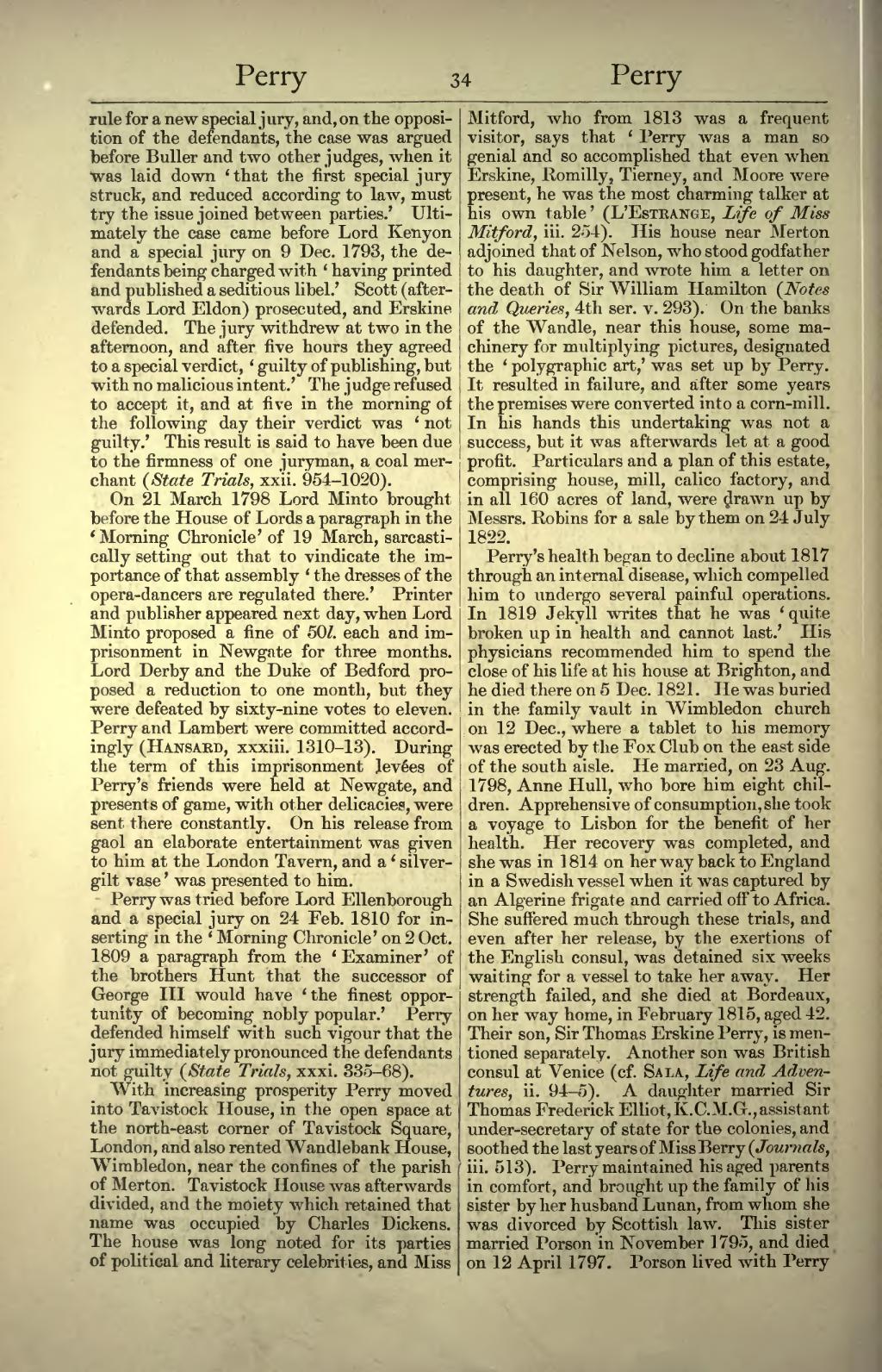rule for a new special jury, and, on the opposition of the defendants, the case was argued before Buller and two other judges, when it was laid down ‘that the first special jury struck, and reduced according to law, must try the issue joined between parties.’ Ultimately the case came before Lord Kenyon and a special jury on 9 Dec. 1793, the defendants being charged with ‘having printed and published a seditious libel.’ Scott (afterwards Lord Eldon) prosecuted, and Erskine defended. The jury withdrew at two in the afternoon, and after five hours they agreed to a special verdict, ‘guilty of publishing, but with no malicious intent.’ The judge refused to accept it, and at five in the morning of the following day their verdict was ‘not guilty.’ This result is said to have been due to the firmness of one juryman, a coal merchant (State Trials, xxii. 954–1020).
On 21 March 1798 Lord Minto brought before the House of Lords a paragraph in the ‘Morning Chronicle’ of 19 March, sarcastically setting out that to vindicate the importance of that assembly ‘the dresses of the opera-dancers are regulated there.’ Printer and publisher appeared next day, when Lord Minto proposed a fine of 50l. each and imprisonment in Newgate for three months. Lord Derby and the Duke of Bedford proposed a reduction to one month, but they were defeated by sixty-nine votes to eleven. Perry and Lambert were committed accordingly (Hansard, xxxiii. 1310–13). During the term of this imprisonment levées of Perry's friends were held at Newgate, and presents of game, with other delicacies, were sent there constantly. On his release from gaol an elaborate entertainment was given to him at the London Tavern, and a ‘silver-gilt vase’ was presented to him.
Perry was tried before Lord Ellenborough and a special jury on 24 Feb. 1810 for inserting in the ‘Morning Chronicle’ on 2 Oct. 1809 a paragraph from the ‘Examiner’ of the brothers Hunt that the successor of George III would have ‘the finest opportunity of becoming nobly popular.’ Perry defended himself with such vigour that the jury immediately pronounced the defendants not guilty (State Trials, xxxi. 335–68).
With increasing prosperity Perry moved into Tavistock House, in the open space at the north-east corner of Tavistock Square, London, and also rented Wandlebank House, Wimbledon, near the confines of the parish of Merton. Tavistock House was afterwards divided, and the moiety which retained that name was occupied by Charles Dickens. The house was long noted for its parties of political and literary celebrities, and Miss Mitford, who from 1813 was a frequent visitor, says that ‘Perry was a man so genial and so accomplished that even when Erskine, Romilly, Tierney, and Moore were present, he was the most charming talker at his own table’ (L'Estrange, Life of Miss Mitford, iii. 254). His house near Merton adjoined that of Nelson, who stood godfather to his daughter, and wrote him a letter on the death of Sir William Hamilton (Notes and Queries, 4th ser. v. 293). On the banks of the Wandle, near this house, some machinery for multiplying pictures, designated the ‘polygraphic art,’ was set up by Perry. It resulted in failure, and after some years the premises were converted into a corn-mill. In his hands this undertaking was not a success, but it was afterwards let at a good profit. Particulars and a plan of this estate, comprising house, mill, calico factory, and in all 160 acres of land, were drawn up by Messrs. Robins for a sale by them on 24 July 1822.
Perry's health began to decline about 1817 through an internal disease, which compelled him to undergo several painful operations. In 1819 Jekyll writes that he was ‘quite broken up in health and cannot last.’ His physicians recommended him to spend the close of his life at his house at Brighton, and he died there on 5 Dec. 1821. He was buried in the family vault in Wimbledon church on 12 Dec., where a tablet to his memory was erected by the Fox Club on the east side of the south aisle. He married, on 23 Aug. 1798, Anne Hull, who bore him eight children. Apprehensive of consumption, she took a voyage to Lisbon for the benefit of her health. Her recovery was completed, and she was in 1814 on her way back to England in a Swedish vessel when it was captured by an Algerine frigate and carried off to Africa. She suffered much through these trials, and even after her release, by the exertions of the English consul, was detained six weeks waiting for a vessel to take her away. Her strength failed, and she died at Bordeaux, on her way home, in February 1815, aged 42. Their son, Sir Thomas Erskine Perry, is mentioned separately. Another son was British consul at Venice (cf. Sala, Life and Adventures, ii. 94–5). A daughter married Sir Thomas Frederick Elliot, K.C.M.G., assistant under-secretary of state for the colonies, and soothed the last years of Miss Berry (Journals, iii. 513). Perry maintained his aged parents in comfort, and brought up the family of his sister by her husband Lunan, from whom she was divorced by Scottish law. This sister married Porson in November 1795, and died on 12 April 1797. Porson lived with Perry
